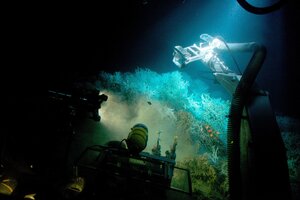Why is the deepest part of the ocean so noisy?
A hydrophone, or underwater microphone, spent almost a month in the deepest part of the ocean and recorded some surprising sounds.

In this undated photo provided by arthowardphotography.com, a deep sea coral reef is seen from a four-man submersible more than 1,000 feet down in the Atlantic Ocean about 50 miles off the southeastern coast of the United States.
arthowardphotography.com/AP
Scientists expected seven miles under the ocean’s surface to be very quiet.
But a team of researchers from the National Oceanic Atmospheric Administration (NOAA), the US Coast Guard, and Oregon State University (OSU) dropped an underwater microphone 36,200 feet to the bottom of the Challenger Deep, the deepest part of the ocean, and were surprised by their findings.
“You would think that the deepest part of the ocean would be one of the quietest places on Earth,” Robert Dziak, a NOAA research oceanographer and chief scientist on the project, tells Oregon State University. “Yet there really is almost constant noise from both natural and man-made sources … Sound doesn’t get as weak as you think it does even that far from the source.”
The Challenger Deep depression is at the southern end of the underwater Mariana Trench, southwest of Guam. Compared to the average ocean depth of 2.3 miles, little is known about the Challenger’s mysterious setting seven miles beneath the ocean surface. Even if Mount Everest, Earth’s tallest mountain at about 5.5 miles above sea level, were relocated to the bottom of the Challenger Deep, more than a mile of water would still cover its peak.
Previous studies have suggested that not much lives in these dark depths. Apart from foot-long shrimp-like crustaceans, sea cucumbers and giant amoebas, the area's lack of light and intense pressure makes the area desolate.
But within 23 days, the device's storage was filled with noise. So if the bottom of the world is pretty much empty, why is it so loud?
“There was a huge amount of energy, high winds, big waves, that made the whole basin noisy,” Dziak tells the Seattle Times. While the hydrophone was underwater, it picked up sounds from a category 4 typhoon overhead and earthquake rumbles below.
Local whales don’t swim more than a mile below the ocean’s surface, but the calls of baleen and toothed whales also carried down to the bottom of the trench.
But the prevalence of human noise may have been the most surprising.
“The project clearly shows that man-made noise is present even in some of the most remote corners of the planet,” explains the Seattle Times. “The nearby island of Guam is on a major transoceanic route, so vessel traffic was a near constant source of noise in the environment, the researchers found.” With transocean traffic increasing, underwater noise pollution is becoming more and more prevalent – and the Challenger Deep proves to be no exception.
“Underwater sounds are a particularly important area of study, as scientists have learned in recent years that too much man-made noise in the ocean – from ship traffic, oil and gas exploration, scientific research, and military sonar – can have harmful effects on its inhabitants,” The Christian Science Monitor’s Lonnie Shekhtman explained last week.
The team of scientists are now planning for another venture in 2017, when a camera will hopefully accompany the hydrophone. But getting to the deepest part of the world isn’t easy.
“We had never put a hydrophone deeper than a mile or so below the surface, so putting an instrument down some seven miles into the ocean was daunting,” Haru Matsumoto, an Oregon State ocean engineer who helped develop the hydrophone, tells OSU.
The pressure is hard for us to imagine, says Matsumoto. At 16,000 pounds per square inch, the pressure at the bottom of Mariana Trench is about 1,088 times that which humans experience on a day-to-day basis.
“We had to drop the hydrophone mooring down through the water column at no more than about five meters per second,” says Matsumoto, which took more than six hours. The team of researchers feared a fast drop would break the hydrophone. “It is akin to sending a deep-space probe to the outer solar system. We’re sending out a deep-ocean probe to the unknown reaches of inner space.”

